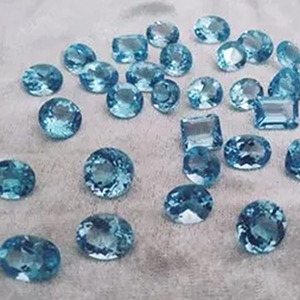Gemstones
Gemstones are valuable or semi-precious minerals that are cut, polished, and incorporated into jewellery and decorative products. They come in a wide variety of colours, shapes, and sizes. See below our gemstones we incorporate into our rings, earrings and the rest of our handmade jewellery.
Ameythst
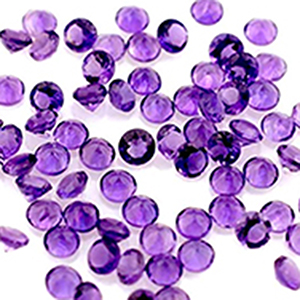
Birthstone: February
Family of gemstone: Quartz (has the same chemical composition and physical properties as amethyst)
Colour: Lilac to blackberry purple
Hardness: 7 (as per Moh’s hardness scale)
Sources: Mainly Brazil, Madagascar, Zambia, Uruguay
Interesting Facts: Amethyst means ‘not drunk’ in Greek and in past times was worn as an amulet to ward off drunkenness
Aquamarine
Birthstone: March
Family of gemstone: Beryl (has the same chemical composition as emerald)
Colour: Light blue to dark blue or blue green
Hardness: 7.5 – 8 (as per Moh’s hardness scale)
Sources: Mainly Brazil, also Australia (Queensland), Burma, China, India, Kenya, Madagascar, Mozambique, Nigeria, Zambia and United States
Interesting Facts: Aquamarine is named after its sea water colour and means ‘water of the sea’ in Latin. Found in 1910 in Brazil, the largest gemstone quality aquamarine weighed 110.5 kg and measured 48.5 cm long and 42cm diameter.
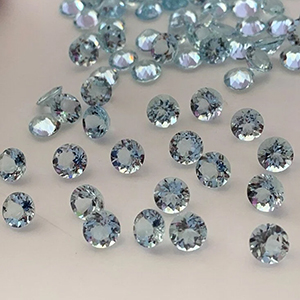
Aventurine
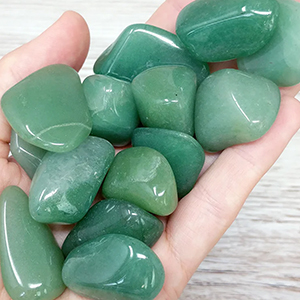
Family of gemstone: Quartz (has the same chemical composition as amethyst)
Colour: Mostly green but can be brown, translucent or opaque
Hardness: 7 (as per Moh’s hardness scale)
Sources: Mainly Brazil, India, Austria, Russia
Interesting Facts: Often has a glitter which comes from tiny inclusions of green mica or hematite.
Mostly cut as cabochon stones.
Blue Topaz
Birthstone: November
Family of gemstone: Topaz
Colour: Colourless, yellow, orange, red-brown, light to dark blue, pink
Hardness: 8 (as per Moh’s hardness scale)
Sources: Mainly Brazil (Light blue topaz have been found in Northern Ireland, Scotland and Cornwall)
Interesting Facts: Topaz is probably named after an island in the Red Sea, formerly Topazos, now Zabargad. Blue topaz have been found in very large sizes and some were mined in the Ukraine weighing about 100 kg each.
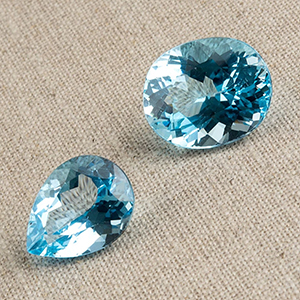
Carnelian
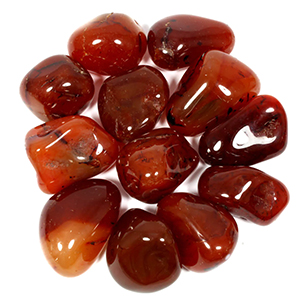
Family of gemstone: Chalcedony (a cryptocrystalline quartz)
Colour: Brownish red to orange, translucent to opaque
Hardness: 6.5 – 7 (as per Moh’s hardness scale)
Sources: Mainly Brazil, India, Uruguay
Interesting Facts: The colour of the carnelian comes from iron and it is reputedly named after the colour of a kornel cherry. In ancient times carnelian was used to make cameos.
Cultured Fresh Water Pearl
Birthstone: June
Family of gemstone: Organic gemstone
Colour: White, cream, golden, pink, silver, grey, black
Hardness: 2.5 –4.5 (as per Moh’s hardness scale)
Sources: China, Japan
Interesting Facts: Pearls have been used in jewellery for 6000 years and in 2500BC a large pearl trade existed in China. The supply of natural pearls has been drastically depleted by pollution and the increase of nitrate levels in the water. An increasing demand for pearls has led to the creation of many cultured pearl farms and cultured pearls account for more than 90% of the total pearl trade. Cultured fresh water pearls are farmed in fresh water.
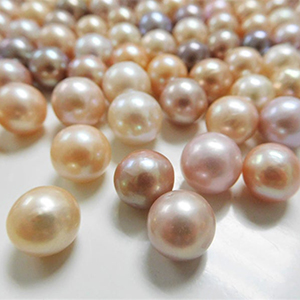
Cultured Pearl
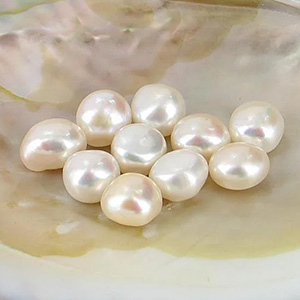
Birthstone: June
Family of gemstone: Organic gemstone
Colour: White, cream, golden, pink, silver, grey, black
Hardness: 2.5 –4.5 (as per Moh’s hardness scale)
Sources: China, Japan
Interesting Facts: Pearls have been used in jewellery for 6000 years and in 2500BC a large pearl trade existed in China. The supply of natural pearls has been drastically depleted by pollution and the increase of nitrate levels in the water. An increasing demand for pearls has led to the creation of many cultured pearl farms and cultured pearls account for more than 90% of the total pearl trade. Cultured pearls are farmed in sea water.
Emerald
Birthstone: May
Family of gemstone: Beryl (has the same chemical composition as aquamarine)
Colour: Light green to dark green
Hardness: 7.5 – 8 (as per Moh’s hardness scale)
Sources: Brazil, Columbia, Ghana, India, Malawi, Mozambique, Namibia, Nigeria, Zambia
Interesting Facts: Emerald is named after the Greek word ‘smaragdos’ which means green stone. Its green colour is so distinctive that the term ‘emerald green’ is commonly used to describe an especially rich shade of green. The British Museum has some rare, specimen emeralds weighing hundreds of carats and an exquisite, 12cm high, emerald vase weighing, 2205 carats and cut from a single piece of emerald crystal, can be found in the Viennese treasury.
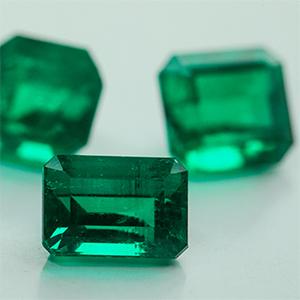
Garnet
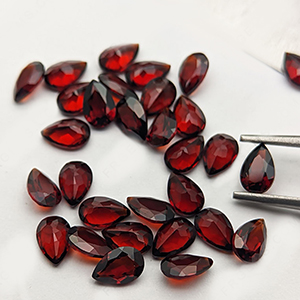
Birthstone: January
Family of gemstone: Garnet
Colour: Burnt orange, deep red, mahogany brown and more unusually yellow to lime green
Hardness: 6.5 – 7.5 (as per Moh’s hardness scale)
Sources: Burma, Brazil, China, Madagascar, Sri Lanka, South Africa, Tanzania, United States
Interesting Facts: A garnet in its crystal form is rounded and so its name is derived from the Latin word for grain, and, also from its similarity to the red seed of a pomegranate.
Green Ameythst
Birthstone: February
Family of gemstone: Quartz (has the same chemical composition and physical properties as amethyst)
Colour: Pale mint green
Hardness: 7 (as per Moh’s hardness scale)
Sources: Mainly Brazil, Madagascar, Zambia, Uruguay
Interesting Facts: Amethyst means ‘not drunk’ in Greek and in past times was worn as an amulet to ward off drunkenness.
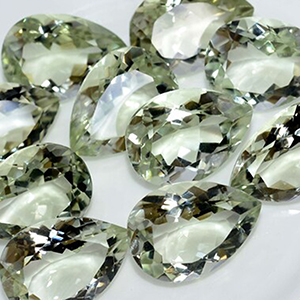
Labradorite
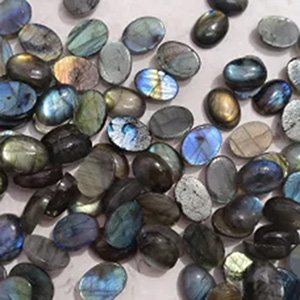
Family of gemstone: Feldspar
Colour: Light to dark grey or brownish with blueish-greenish iridescence (can also be colourless)
Hardness: 6 – 6.5 (as per Moh’s hardness scale)
Sources: Canada, Australia, Madagascar, Mexico
Interesting Facts: Labradorite derives its name from the peninsula of Labrador in Canada, where it was originally found. Its shimmer is often metallic like and is caused by light deflecting from lattice like distortions inside the stone. It is mostly cut and polished with a smooth surface. This style of cutting (without facets) is called a cabochon cut.
Lapiz Lazuli
Family of gemstone: Lapiz Lazuli
Colour: Blue to violet with spots or stripes of white, grey or gold colours, opaque
Hardness: 5- 6 (as per Moh’s hardness scale)
Sources: Afghanistan, Russia, Chile, Burma, Canada, Pakistan
Interesting Facts: The blue colour comes from sulphur. Grey or white inclusions come from calcite deposits and golden inclusions from pyrite. Lapiz lazuli with evenly spread inclusions of pyrite is the most sought after.
Lapiz is sensitive to high temperatures and acids. It has been used in jewellery since prehistoric times and over the ages has also commonly been used for ornaments and inlays.
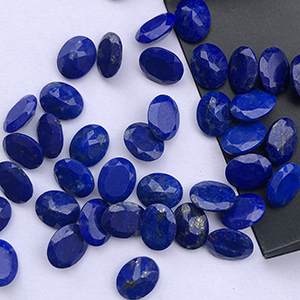
Lemon Quartz
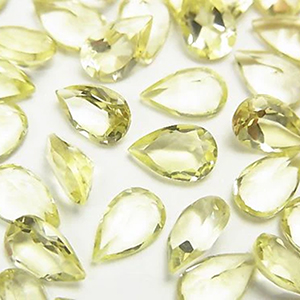
Family of gemstone: Quartz (has the same chemical composition and physical properties as amethyst)
Colour: Yellow to golden brown
Hardness: 7 (as per Moh’s hardness scale)
Sources: Mainly Brazil, Madagascar and United States
Interesting Facts: Lemon quartz or citrine is named after its yellow colour and gets its colour form the presence of iron.
Moonstone
Family of gemstone: Feldspar
Colour: Colourless to white or yellow with a pale sometimes blueish sheen
Hardness: 6 – 6.5 (as per Moh’s hardness scale)
Sources: Sri Lanka, Burma, Brazil, India
Interesting Facts: Moonstone derives its name from its moon like white shimmer. This shimmer is called adularescence. It is always cut and polished with a smooth surface. This style of cutting (without facets) is called a cabochon cut.
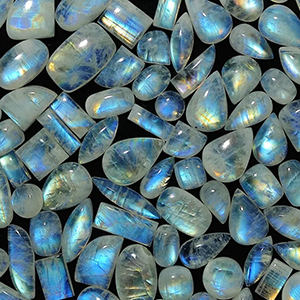
Opal

Birthstone: October
Family of gemstone: Opal
Colour: Milky or grey background with flashes of colours; orange, red, green, blue. ‘Fire Opal’ is bright orange.
Hardness: 6 (as per Moh’s hardness scale)
Sources: Mainly from Australia but also from USA, Brazil, Mexico
Interesting Facts: Mainly cut as cabochon stones, opal are formed from silica gel. It can occur as stalactites or stalagmites and can sometimes be found in fossil wood or shell, or filling a cavity in a sedimentary rock.
Orange Sapphire
Birthstone: September
Family of gemstones: Corundum (has the same chemical composition as ruby)
Colour: Pale to royal blue, dark blue, colourless, pink, peach, orange, yellow, green, purple
Hardness: 9 (as per Moh’s hardness scale)
Sources: Australia, Burma, India, Sri Lanka, Thailand, United States
Interesting Facts: Sapphire is named after its colour – it means blue in Greek. The presence of iron and titanium gives it its colour. Three sapphires, each weighing about 2000 carats, were used to carve the heads of three famous American presidents; Washington, Lincoln, and Eisenhower.
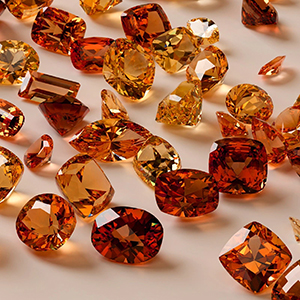
Peridot
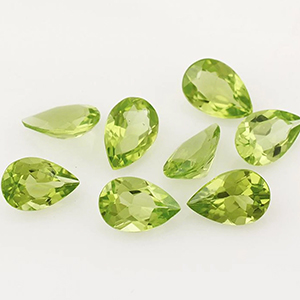
Birthstone: August
Family of gemstones: Peridot
Colour: Vibrant lime green to dark olive green
Hardness: 6.5 – 7 (as per Moh’s hardness scale)
Sources: Burma, Australia, Brazil, China, Egypt, Norway, United States
Interesting Facts: Peridot derives its name from the word ‘faridat’ which is Arabic for gem. Originally mined on the Red Sea volcanic island of Zabargad (St John), it was brought to Central Europe by the Crusaders in the Middle Ages, to be used mainly for ecclesiastical purposes. In 1749 a meteorite fell on Siberia and peridot was discovered inside.
Pink Tourmaline
Family of gemstones: Tourmaline
Colour: Colourless, pink, red, yellow, brown, green blue, multicoloured
Hardness: 7-7.5 (as per Moh’s hardness scale)
Sources: Mainly Brazil, also Burma, India, Nepal, Sri Lanka, Tanzania, United States
Interesting Facts: Some tourmaline crystals are called ‘watermelon’; like the cross section of a watermelon, they are red in the core, with a middle layer of white and an outer layer of green. Pink or red tourmaline can be referred to as ‘rubellite’, which means reddish in Latin. Tourmalines have pyroelectric properties. When rubbed they become electrically charged and will attract dust particles.
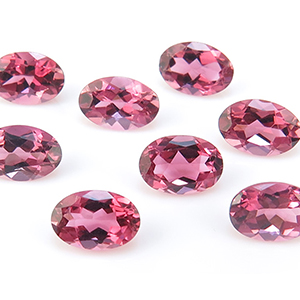
Rose Ameythst
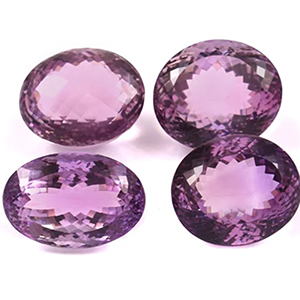
Birthstone: February
Family of gemstones: Quartz (has the same chemical composition and physical properties as amethyst)
Colour: Rose pink to lilac
Hardness: 7 (as per Moh’s hardness scale)
Sources: Mainly Brazil, Madagascar, Zambia, Uruguay
Interesting Facts: Amethyst means ‘not drunk’ in Greek and in past times was worn as an amulet to ward off drunkenness.
Ruby
Birthstone: July
Family of gemstones: Corundum (has the same chemical composition as sapphire)
Colour: Pale to deep red
Hardness: 9 (as per Moh’s hardness scale)
Sources: Mainly Burma, Thailand, Sri Lanka
Interesting Facts: Named after its colour ‘ruber’ meaning red in Latin. The red colour is created by the presence of chromium in the crystal. After diamond, corundum is the hardest material, and, the emery found on nail files is made from finely ground corundum. Due to the rarity of large and fine ruby, ( large rubies often being rarer than comparably sized diamonds), it is one of the most valuable of all the gems.
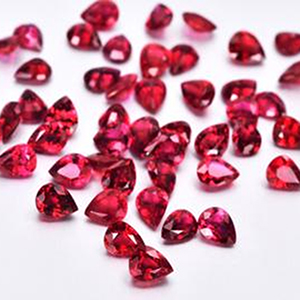
Rutilated Quartz
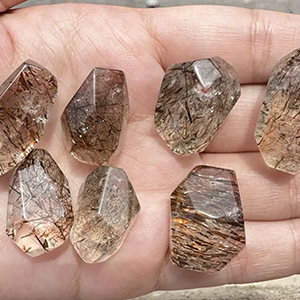
Family of gemstones: Quartz (has the same chemical composition and physical properties as amethyst) Colour; From colourless through pale brown to burnt orange, rutilated quartz contains needle like inclusions which may be red, black or yellow and have a metallic lustre.
Hardness: 7 (as per Moh’s hardness scale)
Sources: Rutilated quartz is found in Madagascar, Brazil, South Africa, India, Sri Lanka, Germany and Switzerland.
Sapphire
Birthstone: September
Family of gemstones: Corundum (has the same chemical composition as ruby)
Colour: Pale to royal blue, dark blue, colourless, pink, peach, orange, yellow, green, purple
Hardness: 9 (as per Moh’s hardness scale)
Sources: Australia, Burma, India, Sri Lanka, Thailand, United States
Interesting Facts: Sapphire is named after its colour – it means blue in Greek. The presence of iron and titanium gives it its colour. Three sapphires, each weighing about 2000 carats, were used to carve the heads of three famous American presidents; Washington, Lincoln, and Eisenhower.
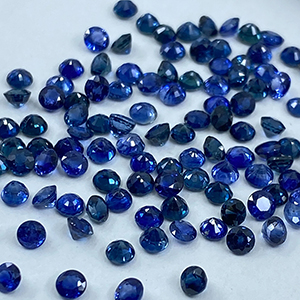
Smoky Quartz
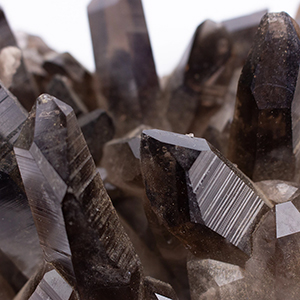
Family of gemstones: Quartz (has the same chemical composition and physical properties as amethyst) Colour; From light brown to grey brown to dark brown.
Hardness: 7 (as per Moh’s hardness scale)
Sources: Smoky quartz is found in Brazil, Madagascar, the Swiss Alps, Colorado (USA), Australia, Spain and the Cairngorm Mountains in Scotland.
Interesting Facts: Smoky quartz was often carved and used in intaglio seals in Roman times.
Tigers Eye
Family of gemstones: Quartz (has the same chemical composition as amethyst)
Colour: Golden yellow to brown, always opaque
Hardness: 6.5 – 7 (as per Moh’s hardness scale)
Sources: Australia, Burma, India, Namibia and USA (California)
Interesting Facts: Mostly cut en cabochon when the surface will have a waxy surface with a chatoyancy which looks like the eyes of a cat or tiger. Due to its porosity it is sensitive to any acid.
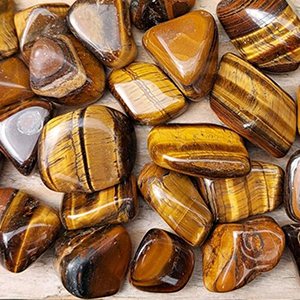
Turquoise
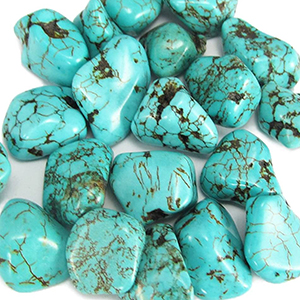
Birthstone: December
Family of gemstones: Turquoise
Colour: Sky blue to green blue
Hardness: 6 (as per Moh’s hardness scale)
Sources: Iran, Tibet, Mexico, USA, Russia, Chile, Australia
Interesting Facts: One of the first gemstones ever to be mined, some turqouise jewellery can be dated back as more than 3000 years old. Turquoise gets its vibrant blue colour from the iron and copper within it. Persian turquoise was brought to Europe by the Turks and so the name Turquoise was derived from the word “Turkish”.
Zircon
Colour: Zircon is found in a range of colors, including white, blue, yellow, orange, brown, rose and green.
Hardness: 7-7.5 (as per Moh’s hardness scale)
Sources: Cambodia, Sri Lanka, Thailand, Myanmar and Australia.
Interesting Facts: In the middle ages, zircon was said to aid sleep, bring prosperity, and promote honour and wisdom in its owner. The name probably comes from the Persian word ‘zargun’ which means ‘gold-coloured’, although zircon comes in a wide range of different colours.
